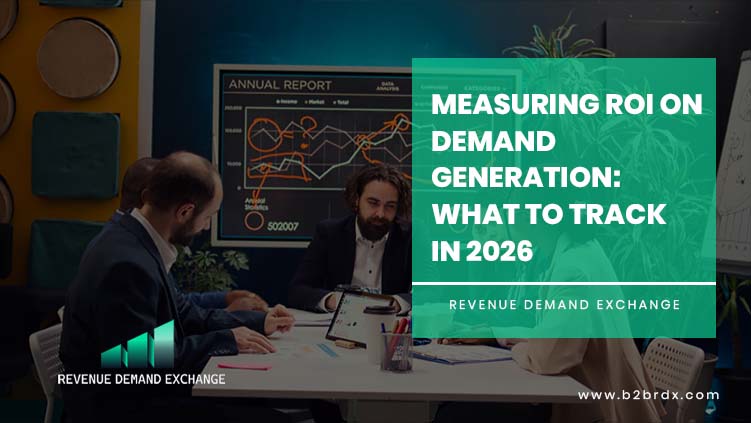Measuring ROI on Demand Generation: What to Track in 2026

Demand creation has become the most important part of growth strategies in today’s competitive B2B world. Businesses don’t just rely on outbound marketing anymore; they also work on keeping customers interested and creating long-term connections with them. But as marketing channels, automation tools, and consumer expectations get more complex, one big question comes to mind: how do you figure out the return on investment (ROI) of demand creation in 2026?
Lead generation frequently counts form fills or downloads as signs of success. Demand generation, on the other hand, focuses on making people aware of your product, teaching them about it, and helping them along the way until they are ready to buy. That makes it harder to figure out the ROI. Organizations need to go beyond surface-level metrics and keep an eye on more important ones that show engagement, pipeline influence, and revenue contribution.
Below, we’ll look at the most important measures to keep an eye on in 2026 to get a good idea of the return on investment for demand generation.
Pipeline Contribution and Influence
Keeping track of how much pipeline marketing initiatives bring in or change is one of the best methods to figure out the ROI of demand creation. In 2026, businesses don’t only look at leads; they also look at how campaigns help create sales-qualified opportunities (SQOs) and real deals that are in the pipeline. Companies may now use advanced attribution models to see how different efforts, including webinars, content syndication, or targeted ads, affect different parts of the buyer experience.
Customer Acquisition Cost (CAC) vs. Lifetime Value (LTV)
It’s not just about getting new leads; it’s also about making money. In 2026, more and more organizations are comparing Customer Acquisition Cost (CAC) to Customer Lifetime Value (LTV) to see if their efforts to generate demand are long-lasting. If the CAC is going up faster than the LTV, it’s a sign that your techniques for generating demand aren’t working. Companies can better figure out how their campaigns really affect their finances and change how much they spend by comparing the two.
Marketing Qualified Leads (MQLs) to Sales Qualified Leads (SQLs) Conversion
Many companies are moving away from traditional MQLs, but it’s still important to keep track of how leads go through the funnel. The conversion rate from MQLs to SQLs shows how good the activities that generate demand are. Companies will be able to keep better track of this statistic in 2026 with AI-powered scoring models that look at engagement intent signs like visits to product pages, attendance at webinars, or behavior of buying committees.
Multi-Touch Attribution Across Channels
People today interact with a brand on many different platforms before deciding to buy. A potential customer might first read a blog piece, then go to a webinar, then see a tailored ad, and ultimately ask for a demo. To find out how much money you made in 2026, you need to use multi-touch attribution to figure out how much each touchpoint was worth. Using simply first-touch or last-touch attribution can offer you a skewed picture, but multi-touch attribution models, such as W-shaped or data-driven attribution, show you a more complete picture of which campaigns are bringing in conversions and sales.
Account Engagement in ABM Programs
Account-Based Marketing (ABM) is becoming a key part of generating demand, especially for businesses. In 2026, evaluating ROI isn’t only about how many leads you get; it’s also about how deeply your target accounts are engaged. Metrics like account engagement score, buying committee participation, and time spent with brand assets let you see how well demand creation is working. The more involved the account is, the more likely it is to convert into a sale.
Revenue Attribution and Closed-Won Deals
The most straightforward way to analyze the return on investment (ROI) for demand creation is to look at the money made from agreements that were influenced by marketing. This doesn’t mean that every contract will come via marketing, but keeping track of how many closed-won agreements were influenced by demand generation gives you a clear picture of the effect. In 2026, it will be easy to see how campaigns affect closed revenue thanks to better CRM and marketing automation capabilities. This helps marketing and sales work together and shows that marketing has a direct impact on the bottom line.
Content Performance and Engagement Metrics
Content is still the most important part of generating demand. Blogs, whitepapers, podcasts, and interactive tools help people learn about and get involved with things. To find out the ROI, businesses need to keep track of how well their content is doing by looking at things like how long people spend on a page, how many times it is shared and downloaded, how many people come back to the site, and how many people convert from content CTAs. Businesses may figure out which kinds of content have the most impact on the pipeline and which ones require work by looking at these indicators. In 2026, AI-driven analytics let marketers see buyer intent more clearly by looking at how people interact with content.
Sales Cycle Acceleration
One ROI indicator that people often forget about is if demand creation cuts down on the time it takes to close a sale. A good demand generation engine doesn’t simply get people to know about your product; it also teaches them about it, answers their questions, and builds interest so that when they talk to sales, they are more knowledgeable and ready to buy. A good way to measure ROI is to look at the average length of the sales cycle before and after starting demand generating activities.
Brand Awareness and Share of Voice (SOV)
Brand awareness is a key metric for generating demand, even if it’s tougher to link it directly to ROI. Tools keep track of share of voice across search, social, and industry media in 2026. If your brand is always in front of the correct people, it keeps your company top of mind and directly feeds the pipeline. Brand lift studies, sentiment analysis, and search impression share are all ways to measure ROI from a brand visibility point of view.
Conclusion
In 2026, measuring ROI on demand generation means more than just tracking leads. It needs a whole-system approach that takes into consideration pipeline contribution, revenue impact, account engagement, and long-term profitability. Companies now can see more clearly than ever how demand generation drives revenue thanks to powerful AI technologies, multi-touch attribution models, and better interaction across sales and marketing platforms.
Companies that do well are the ones that connect marketing analytics to business results and focus on revenue, efficiency, and customer value instead of vanity metrics. In short, the real measure of demand generation ROI is how well it not only brings in leads but also speeds up revenue growth, boosts profits, and builds brand equity.


